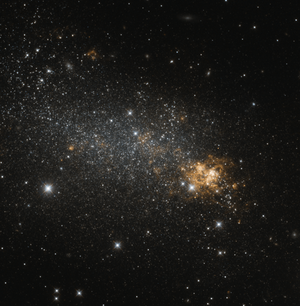
The Sculptor Group is a loose group of galaxies visible near the south galactic pole. The group is one of the closest groups of galaxies to the Local Group; the distance to the center of the group from the Milky Way is approximately 3.9 Mpc (12.7 Mly).

Messier 83 or M83, also known as the Southern Pinwheel Galaxy and NGC 5236, is a barred spiral galaxy approximately 15 million light-years away in the constellation borders of Hydra and Centaurus. Nicolas-Louis de Lacaille discovered M83 on 23 February 1752 at the Cape of Good Hope. Charles Messier added it to his catalogue of nebulous objects in March 1781.

The Pegasus Dwarf Spheroidal is a dwarf spheroidal galaxy about 2.7 million light-years away in the constellation Pegasus. The Pegasus Dwarf is a member of the Local Group and a satellite galaxy of the Andromeda Galaxy (M31).

NGC 404 is a field galaxy located about 10 million light years away in the constellation Andromeda. It was discovered by William Herschel in 1784, and is visible through small telescopes. NGC 404 lies just beyond the Local Group and does not appear gravitationally bound to it. It is located within 7 arc-minutes of second magnitude star Mirach, making it a difficult target to observe or photograph and granting it the nickname "Mirach's Ghost".

The Centaurus A/M83 Group is a complex group of galaxies in the constellations Hydra, Centaurus, and Virgo. The group may be roughly divided into two subgroups. The Cen A Subgroup, at a distance of 11.9 Mly, is centered on Centaurus A, a nearby radio galaxy. The M83 Subgroup, at a distance of 14.9 Mly, is centered on the Messier 83 (M83), a face-on spiral galaxy.
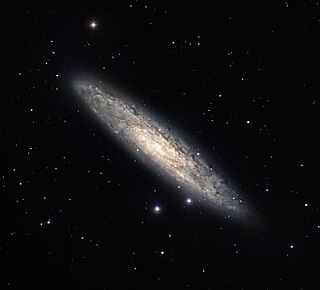
The Sculptor Galaxy is an intermediate spiral galaxy in the constellation Sculptor. The Sculptor Galaxy is a starburst galaxy, which means that it is currently undergoing a period of intense star formation.
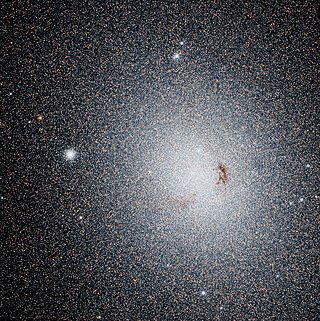
NGC 185 is a dwarf spheroidal galaxy located 2.08 million light-years from Earth, appearing in the constellation Cassiopeia. It is a member of the Local Group, and is a satellite of the Andromeda Galaxy (M31). NGC 185 was discovered by William Herschel on November 30, 1787, and he cataloged it "H II.707". John Herschel observed the object again in 1833 when he cataloged it as "h 35", and then in 1864 when he cataloged it as "GC 90" within his General Catalogue of Nebulae and Clusters. NGC 185 was first photographed between 1898 and 1900 by James Edward Keeler with the Crossley Reflector of Lick Observatory. Unlike most dwarf elliptical galaxies, NGC 185 contains young stellar clusters, and star formation proceeded at a low rate until the recent past. NGC 185 has an active galactic nucleus (AGN) and is usually classified as a type 2 Seyfert galaxy, though its status as a Seyfert is questioned. It is possibly the closest Seyfert galaxy to Earth, and is the only known Seyfert in the Local Group.
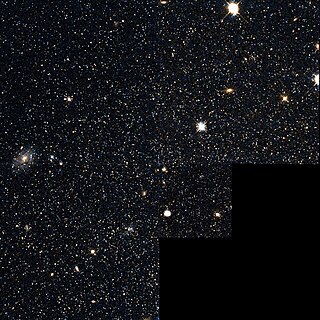
Andromeda I is a dwarf spheroidal galaxy (dSph) about 2.40 million light-years away in the constellation Andromeda. Andromeda I is part of the local group of galaxies and a satellite galaxy of the Andromeda Galaxy (M31). It is roughly 3.5 degrees south and slightly east of M31. As of 2005, it is the closest known dSph companion to M31 at an estimated projected distance of ~40 kpc or ~150,000 light-years.
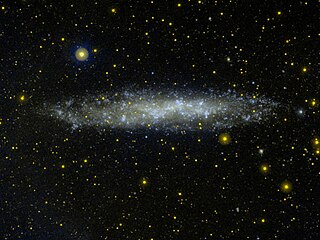
NGC 3109 is a small barred Magellanic type spiral or irregular galaxy around 4.34 Mly away in the direction of the constellation of Hydra. NGC 3109 is believed to be tidally interacting with the dwarf elliptical galaxy Antlia Dwarf. It was discovered by John Herschel on March 24, 1835 while he was in what is now South Africa.

The Phoenix Dwarf is a dwarf irregular galaxy discovered in 1976 by Hans-Emil Schuster and Richard Martin West and mistaken for a globular cluster. It is currently 1.44 Mly away from Earth. Its name comes from the fact that it is part of the Phoenix constellation.

Leo II is a dwarf spheroidal galaxy about 690,000 light-years away in the constellation Leo. It is one of 24 known satellite galaxies of the Milky Way. Leo II is thought to have a core radius of 178 ± 13 pc and a tidal radius of 632 ± 32 pc. It was discovered in 1950 by Robert George Harrington and Albert George Wilson, from the Mount Wilson and Palomar Observatories in California.

NGC 4945 (also known as Caldwell 83) is a barred spiral galaxy in the constellation Centaurus, visible near the star Xi Centauri. The galaxy was discovered by James Dunlop in 1826 and is thought to be similar to the Milky Way Galaxy, although X-ray observations show that NGC 4945 has an unusual energetic Seyfert 2 nucleus that might house a supermassive black hole. Around the nucleus of the galaxy, there is a dense disk of dust and gas, along with many dense star clusters. This object has an estimated mass of 1.4+1.4
−0.7×1011 M☉.

NGC 3077 is a small disrupted elliptical galaxy, a member of the M81 Group, which is located in the northern constellation Ursa Major. Despite being similar to an elliptical galaxy in appearance, it is peculiar for two reasons. First, it shows wispy edges and scattered dust clouds that are probably a result of gravitational interaction with its larger neighbors, similar to the galaxy M82. Second, this galaxy has an active nucleus. This caused Carl Seyfert in 1943 to include it in his list of galaxies, which are now called Seyfert Galaxies. However, NGC 3077, though an emission line galaxy, is today no longer classified as a Seyfert galaxy.
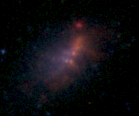
NGC 2915 is a blue dwarf galaxy located 12 million light-years away in the southern constellation Chamaeleon, right on the edge of the Local Group. The optical galaxy corresponds to the core of a much larger spiral galaxy traced by radio observation of neutral hydrogen.

NGC 5102 is a lenticular galaxy in the Centaurus A/M83 Group of galaxies. It was discovered by John Herschel in 1835.

NGC 5253 is an irregular galaxy in the constellation Centaurus. It was discovered by William Herschel on 15 March 1787.

The Bubble Nebula in Barnard's Galaxy has the official designation of Hubble 1925 I as it was the first object recorded in a paper by Hubble 1925. It includes areas of bright H II emission. It is located north-west of the larger Hubble 1925 III.

NGC 247 is an intermediate spiral galaxy about 11.1 Mly away in the constellation Cetus. This distance was confirmed in late February 2011. Previous measurements showed that the galaxy was about 12.2 Mly away, but this was proved to be wrong. NGC 247 is a member of the Sculptor Group, and is 70 000 light years in diameter.

NGC 4236 is a barred spiral galaxy located in the constellation Draco.

NGC 4449, also known as Caldwell 21, is an irregular Magellanic type galaxy in the constellation Canes Venatici, being located about 13 million light-years away. It is part of the M94 Group or Canes Venatici I Group that is relatively close to the Local Group hosting our Milky Way galaxy.
